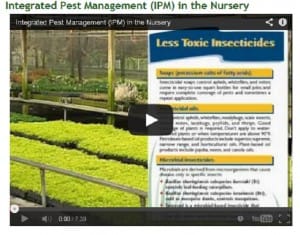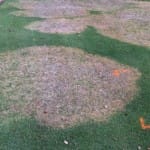The Athens-Clarke County Commission approved on June 3, 2014 a new law that will allow people inside the city limits to rent goats and sheep to help get rid of invasive plants on their property (info taken from the Center for Invasive Species blogspot). Read the following story to find out why.
The following article is by Merritt Melancon, news editor with the University of Georgia College of Agricultural and Environmental Sciences
Goats and sheep have a reputation for eating vegetation that most other grazing animals would not touch.
This trait makes them invaluable to people who need to raise livestock in tough climates, but it’s also made them popular for landowners who need to clear brush or invasive plants from overgrown parcels.
The nimble grazers can get into overgrown areas that even the most dedicated groundskeeper or gardener won’t chance. They’ve proven to be a low-impact, low-cost way to control invasive plants like privet, kudzu, honeysuckle and English ivy.
The practice of using sheep and goats to clear out unwanted brush is called targeted grazing, and many government agencies, municipalities and private landowners are using it to keep vacant lots, steep back yards, parks and right-of-ways clear of brush.
When is it time to bring in a herd?
Targeted grazing is a suitable option, whether a landowner is dealing with acres of stream bank, a detention pond or a small back yard, but it’s not meant to replace basic maintenance, said Brian Cash, owner of EWE-niversally Green sheep rental service in Dunwoody.
“We’re not a lawn mowing service,” Cash said. “We’ll do that, but we like to focus on overgrown yards and lots.”
Cash often works with new homeowners in and around downtown Atlanta who have purchased foreclosed homes with overgrown lawns and local government agencies needing to clear brush from public lands.
Sheep and goats are most useful when an area is so overgrown that no one else wants to clear it out. Even if its just a small yard, most homeowners, and many landscapers, don’t want to work in an area that’s choked with poison ivy, poison oak and briars, he said.
Sheep and goats are also useful in areas that are too steep or too wooded to use a tractor to clear out brush.
“If you can do it with a bush hog on a tractor, then that would be cheaper, but if you need a guy with a weed whacker out there, then I’m cheaper,” said herdswoman Jennif Chandler, of Shady Brook Farm in Colbert.
Chandler and her sheep have worked with the University of Georgia College of Agricultural and Environmental Sciences on the Athens campus to clear invasive plants including privet, kudzu and honeysuckle from along the bank of the Oconee River.
She also works with homeowners in the Athens area to clear Kudzu covered hills and backyards.
While goats and sheep are a surefire and efficient way to clear out a choked backyard or lot, there are a few things that homeowners should consider before buying a half-dozen goats or even hiring a service like Cash or Chandler’s.
They’ll eat everything
While herdsmen and women out on the West Coast are training goats and sheep to nibble around delicate plants like grape vines and other crops, targeted grazing isn’t a technique homeowners would want to try around their prize hydrangeas or a heirloom rose bush.
In fact, some ornamental plants are seriously toxic to sheep or goats. Examples include azaleas and Japanese yew.
“They’re not very discriminant,” said Sarah Workman, an Extension Agroforestry Specialist with the CAES. “If there’s something you don’t want them to eat, you need to protect it.”
While goats and sheep eat pretty much the same thing, sheep prefer broad-leaf weeds like ivy or kudzu, and goats seem to prefer woodier plants, Cash said.
Sheep usually can clear an area up to about a five-foot height, but goats can climb and take care of plants up to seven feet off the ground.
Because of their climbing ability, goats can take care of larger plants. However, that skill and natural curiosity, makes them more likely to escape and antagonize neighborhood dogs.
Cash usually sends a few goats along with his sheep herd to get the best of both worlds, but he’s careful to select his best-behaved goats.
Graze, wait and repeat
If a homeowner’s goal is to eradicate a specific invasive species, it may take repeated grazing to accomplish that goal, Workman said.
She and Chandler organized the first targeted grazing demonstration at UGA last year. The project, an effort to remove privet from a portion of the River Road area, is ongoing.”
These invasive plants are invasive because they are so persistent,” Workman said. “The idea is that the repeated introduction of the animals will deplete the root reserve of the (invasive) shrub.”
The shrubby stuff and woody vines are things that need repeated browsing,” Workman said. “And hopefully the more they’re eaten and knocked back, the less strength they have to regrow.”
Chandler’s sheep are scheduled to be back in action this summer to continue the eradication effort.
Managing the herd takes expertise
Herdsmen and women, like Cash and Chandler, have worked with their animals long enough to know how they’ll graze a specific area and how to meet homeowners’ goals for targeted grazing. Their customers get the benefit of that expertise when they rent their herds.
Another option is for a homeowner to purchase a few sheep or goats, but they need to be ready for the responsibility, said Will Getz, professor of animal science at Fort Valley State University’s Georgia Small Ruminant Research and Extension Center.
Zoning laws prohibit many suburban and urban homeowners from keeping any goats or sheep in their backyard. Additionally, suburban, urban and even rural landowners will face the challenge of keeping their herds contained and safe from neighborhood dogs or coyotes.
Moreover, there is the matter of food.
An acre of grass and brush can support about a half-dozen goats or sheep over the long-term, Getz said. If a landowner wants to load their land with more than six sheep or goats per acre, they’ll clear it out quickly.
“If you exceed that stocking intensity, then the animals are going to clear the area out more quickly,” Getz said. “But then you need to be prepared to sell them or otherwise get them off of your land when they’ve finished, either that or start buying feed.”
Homeowners interested it either renting or buying goats or sheep to clear their land should contact their local UGA or FVSU Cooperative Extension agent and the zoning or public development office in their county or city.
 Matthew Chappell, Associate Professor UGA & Statewide Extension Specialist (Nursery Crops)
Matthew Chappell, Associate Professor UGA & Statewide Extension Specialist (Nursery Crops)















